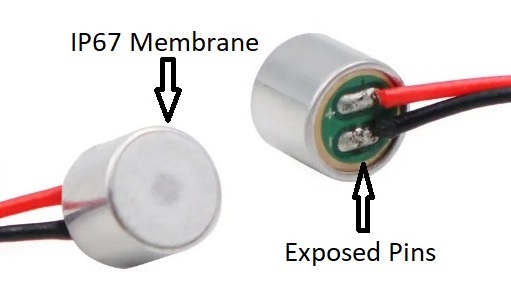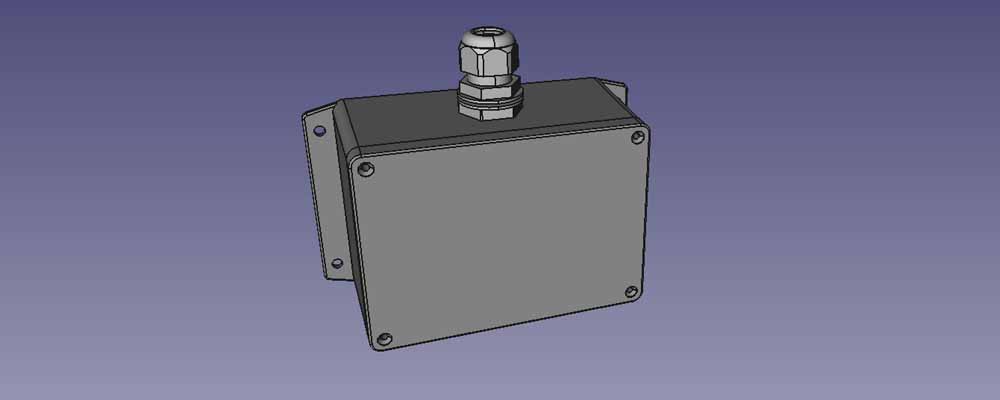A cable gland friendly IP67 microphone is included with PCB Artists sound sensors that feature external electret microphone support. This article lists some guidelines and issues for consideration when using the IP67 microphone with outdoor applications.
Protecting the Microphone
The IP67 microphone included with our electret microphone based decibel sensors have a protective IP67 membrane on the front side, and soldered wires on the rear side.
The conductors are soldered on to the microphone, but are not sealed with a sealant to allow for bending and insertion into a cable gland. This exposure leaves the rear end of the microphone vulnerable to effects of water ingress.
Therefore, the application must ensure that the rear end is protected from the elements (as it would be, if the microphone were to be inserted through a cable gland).
Note that the microphone’s rear end does not have a vent hole and if needed, the solder joints can be sealed with epoxy, silicone, or other non-corrosive resins in the end application.
Using a Microphone Boot
The standard IP67 microphone supplied with the current line of outdoor sound level sensor modules is a 6mm diameter electret microphone with a body length of 5mm.
The twisted pair cable length is 100mm and the microphone uses a 2-pin 2.5mm-pitch JST-XH male connector.
If a rubber boot is preferred over a cable gland for mounting, 6mm microphone rubber boots are commonly available off-the-shelf for purchase. For bulk orders, we can ship rubber boots with the microphone and sensor.
Using a Cable Gland
The microphone barrel has a length of 5mm, which is long enough for using the microphone with cable glands. The 5mm barrel length creates a good seal when the microphone is inserted into a cable gland and tightened correctly.
It is important to use a breathable cable gland instead of regular cable glands to prevent moisture build-up and air pressure differential. An example of a breathable cable gland that we recommend is the Multicomp Pro MP010322.
When inserting the microphone into the cable gland, make sure that the microphone protrudes 0.5mm – 1mm outside of the cable gland seal. This ensures a tight fit and the microphone cannot slide in or out due to uneven tightening pressure. To prevent the microphone from being pushed in, the cable gland interior may be filled up with a sealant if needed.
Mounting Orientation
As always, basic guidelines for microphone mounting do apply, including MEMS microphone module mounting guidelines.
However, special care needs to be taken when installing the microphone in outdoor environments where it can be exposed to dust, water, and freezing temperatures.
The microphone must NOT be mounted in a way that
- Causes debris and dust to accumulate on the membrane at a high rate
- Causes water to deposit and accumulate on the membrane or cable gland opening
- Causes accumulated dirt to get caked into the membrane when water falls on the membrane
- Causes a temperature gradient which induces condensation on the enclosure and microphone opening
Order the Sound Level Sensor (with IP67 Microphone)
The above mentioned sound level sensor module is now available for purchase on our store page.
The product is in production and will be supported at least until 2030.
Change Log
- 27 April 2024
– Initial release



